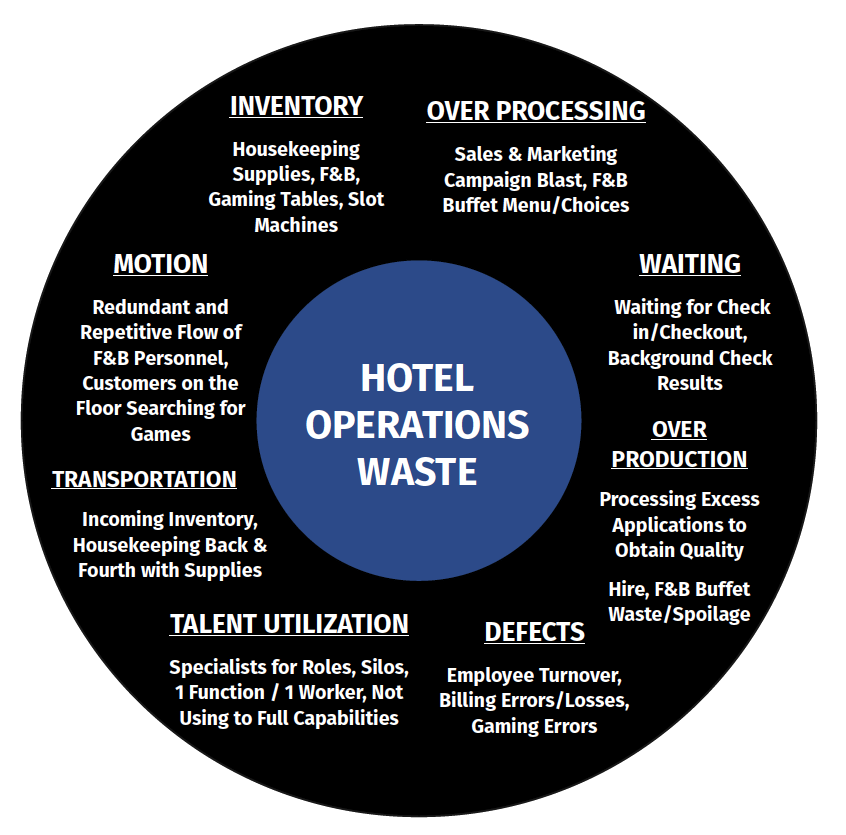
If you haven’t heard of Cost of Poor Quality (COPQ) and its negative impact on your organization’s income and profit yield, read on. Whether you are in hotel operations, casino marketing, legal compliance, gaming operations, food and beverage, or running some of the commercial properties, COPQ should be a strategic driving factor within every Tribal organization.
Cost of Poor Quality (COPQ) has been used within manufacturing, healthcare, military operations, and more organizations for many years to great avail. This business technique is now being embraced within the Tribal gaming and hospitality community to improve the bottom line.
The problem is that there is a lack of understanding, proper application and apprehension for leadership to uncover, identify and assign a financial impact to the business when operations are inadequate. Fear not! With Raving’s help, along with solutions experts and partners at Lean Revisions, Tribal entities are beginning to successfully apply Lean Operations Management to eliminate impediments to operational excellence, increased profits, and sustained growth.
To begin with, the “Eight Types of Waste” that reside within and create excessive costs, operational breakdowns, and negative guest experiences needed to be identified so that resources can be assigned to permanently eliminate them from systems, processes, and procedures. This is where the Raving and Lean Revisions teams come in. We assist Tribal gaming and hospitality organizations with training their team members to identify these eight wastes and assign a financial Cost of Poor Quality (COPQ) that helps organizations develop strategic improvements, thus eliminating them from the business.

Figure 1 illustrates the typical “Eight Types of Waste” and operational challenges that are found in most Tribal gaming and hospitality casinos and resorts.
Many organizations look at post-quarterly profit margins, operating costs, labor and overhead, but don’t realize how the daily functions within the enterprise impact the bottom line. This is where Lean Operations Management comes in.
Lean makes Tribal operations proactive as opposed to reactive when assessing the health of the organization. By measuring what works, what drives success, and what is adding value to the guest experience. Lean is all about solutions, and by selecting, implementing and sustaining them, leadership will realize substantial business gains that are directly aligned with “Key Performance Indicators,” strategic financial goals and objectives.
Example 1: Let’s take a look at one of the challenges a casino client had and how Lean solutions helped generate revenue and improve the guest experience.
The casino identified an opportunity within their jackpot procedure, since they would take the guest away from the machine and walk them up to the cashier’s cage to do the paperwork and all the legal paperwork and verifications. And then one day, an epiphany happened by implementing Lean. Because they wasted a lot of time with this. They realized time and motion were wasting a lot of labor and guest time, along with revenue loss by pulling the guest away from the game. So they redesigned the procedure, and now they go to the player with money and paperwork in hand. The guest doesn’t even have to get up and can keep playing. The 400-room casino resort estimated that this simple, yet efficient change will result in an annual mid-five-figure increase in revenue.
Example 2: This mid-sized casino resort client uncovered an issue within their facilities service processes and the impact to overall property revenue.
They realized that “time is money,” and repairs take time. Their response time from the request by a guest to an engineer arrival had wide variation. The average response time was 35 minutes, and their objective was to reduce response time to 20 minutes or less. They engaged the crew, mapped the current process, and identified that the current process for service requests relied heavily on email, telephone, radio calls, maintenance care, and pass attack (fly-by/bum-rush). The outcome resulted in inefficiencies, inconsistencies, no tracking histories, communication errors, and lost requests.
By implementing Lean methods, the team redesigned the procedures, and the new state of operations is an average response time of 20 minutes. They developed new communication protocols, training and adherence, while addressing staffing sufficiency, staffing deployment and skills, along with parts inventory management, project interruption, and operation interference.
The financial gains from this project:
Capital investment required $0.00
Additional staffing required $0.00
Additional operating expense $0.00
Ten guests x 365 x $200 = $730,000 estimated annual revenue increase by resolving maintenance issues and getting guests to the gaming floor, restaurants and other revenue-generating property locations.
So, you might be asking, how do you begin?
First, you want to make sure that your management team is committed to leading the transformation. Second, train your workforce on the Lean methods and tools that will help them execute operational improvements within their realm of responsibility and scope. These tools have different levels of knowledge and skills to be applied for different types and sizes of business needs. To learn more about Lean, I encourage our readers to watch the 10 videos that are roughly about five minutes each that walk through the Lean methodology and implementation roadmap. They can be found on the Lean Revisions website at LeanRevisions.com under the Training tab. For more information, contact Daniel Wood at daniel@betravingknows.com.



